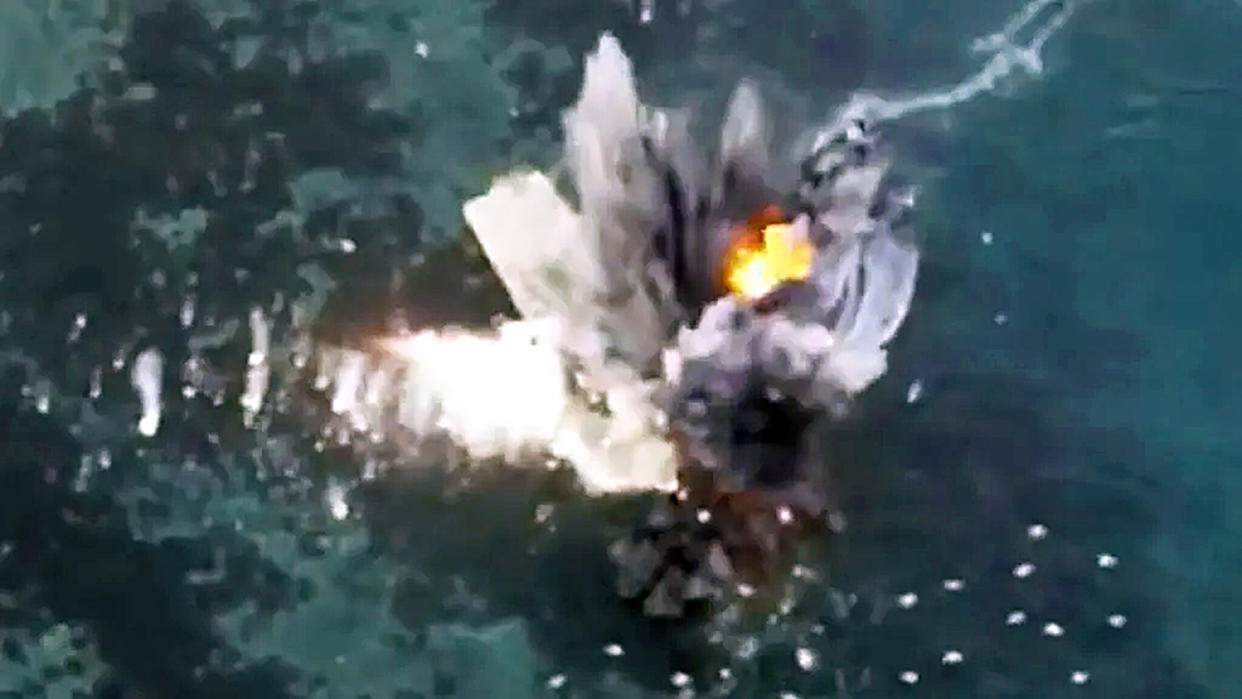Small, Agile Houthi Drone Boat Shown Obliterating Ship During Test

Yemen has released a video showing its Tufan-1 (also written Toofan-1) uncrewed surface vessel (USV), or drone boat, blowing apart a target vessel during a test. The video follows photos of the much cruder Houthi USV that struck the bulk cargo carrier M/V Tutor in the Red Sea earlier this month, an incident you can read more about here. Yemeni homemade Toofan 1 USV, carrying a warhead of 150kg and a speed of 35 nautical miles/hour. pic.twitter.com/h6r4T6LywH— MenchOsint (@MenchOsint) June 21, 2024 The latest video shows multiple Tufan-1s on display in an exhibition-type environment, providing a good look at the relatively sleek craft, as well as other larger USV types. The little drone boat features a wave-cutting v-hull form, similar to some of the various drone boats that have been used to great effect by Ukraine in the Black Sea. While the Tufan-1 has been presented before, what’s really new here is the footage showing one of the craft being tested in a live-fire scenario. This portion includes the Tufan-1 moving at speed through the water. Some shots show a person at the wheel. The vessels are clearly built from a crewed design and can feature remote or hands-on control. The video then cuts to the attack on an abandoned vessel, the interior of which is ripped apart by the detonating warhead. The Tufan-1 maneuvers as it approaches the target. via X Detonation of the warhead carried by the Tufan-1. via X The remains of the target vessel after the impact of the Tufan-1. via X A still image that shows a human operator in a Tufan-1. via X While the overall size of the Tufan-1 indicates a craft that’s notably smaller than many other Houthi USVs, this should make it faster, more agile, and tougher to engage, while the size of the explosion indicates a very powerful warhead. According to a caption in the video, the warhead weighs 330 pounds and the craft has a top speed of 35 knots. There is no range specified although the same text suggests that the Tufan-1, which is powered by a commercial-type outboard motor, is optimized for “nearby maritime targets, fixed and moving.” The Houthis have a track record of developing and utilizing USVs dating back to the mid-2010s. They have attempted multiple attacks using these craft since the start of the Israel-Hamas war, but only struck a ship for the first time when they successfully engaged the M/V Tutor last week. A video showing a Houthi USV attack on a Saudi frigate in January 2017: As we have mentioned, the USV that hit the Liberian-flagged, Greek-owned M/V Tutor was a very different type of design, looking like one of the skiff-type fishing vessels that ply their trade in the Red Sea region. It also had a pair of human dummies to confuse defenders, upping the anti-for engaging the craft. The specifications of the USV used to attack the M/V Tutor are unclear. Houthi Skiff-type USVs have been in use as far back as 2020 and a similar-looking craft was found washed up in the Bab al Mandeb Strait in January. That example was carrying a warhead weighing around 110 pounds — significantly less than now claimed for the Tufan-1. The explosion that rippled into the M/V Tutor looked quite powerful though, as you can see below. The Houthis released footage from strikes with unmanned, remote-controlled boats laden with explosives targeting a Greek-owned M/V TUTOR bulk carrier in the Red Sea on June 12.The attack caused severe damage at the stern and flooding. The vessel is believed to have sunk, UKMTO… pic.twitter.com/kZJFER2s4w— Status-6 (Military & Conflict News) (@Archer83Able) June 19, 2024 Photos of Houthi kamikaze USV right before it struck Greek-owned cargo ship Tutor.The ship's guard were totally confused as to what they were observing.They couldn't even react before it hit the ship. https://t.co/ZwFlWnsFAR pic.twitter.com/8ORRrvZWH6— Clash Report (@clashreport) June 17, 2024 The type of guidance used by the Tufan-1, in this video at least, is unclear, although the Houthis have demonstrated the ability to track their USVs using GPS and to utilize a video feed. This would potentially allow them to be controlled remotely from land, as well as from crewed vessels, with skiffs having been used for this purpose in the past. A head-on view of a Tufan-1 from the new video. via X As we have previously reported, the Houthis began employing USVs against Red Sea shipping in its current campaign back in January. In response to the threat, the U.S. and its allies have gone on the offensive to hunt down Houthi USVs — as well as missiles and aerial drones — both before and after they are launched. Despite this campaign, there appears to be no letup in the Houthi attacks, including the use of drone boats. Indeed, the success of the attack on the M/V Tutor — which resulted in severe flooding, damage to the engine room, and left one civilian mariner missing — will only have increased the militants’ resolve. A day after the Tutor was hit, they struck M/V Verbena, a Palauan-flagged, Ukrainian-owned, Polish-operated bulk cargo carrier in two separate missile attacks. The crew was forced to abandon the ship due to continued fires and an inability to control them. This is how Ukrainian-owned, Polish-operated M/V Verbena cargo ship looks like after Houthi attacks.Two cruise missiles launched by Yemen’s Houthis struck the ship in the Gulf of Aden, severely injuring one of the crew. pic.twitter.com/UOOmyhGG1u— Clash Report (@clashreport) June 15, 2024 The appearance of the Tufan-1 in this dramatic new video may well signal that the Houthis are also preparing to deploy this USV in their anti-shipping campaign in the Red Sea if they haven’t already. Regardless, it seems that the threat posed by Houthi drone boats will continue to pose an increasing risk to all vessels sailing through the highly important Red Sea and the waters around it. Contact the author: thomas@thewarzone.com

